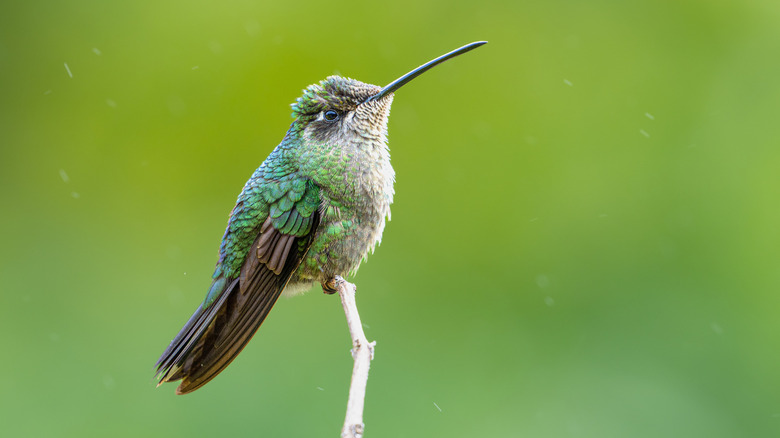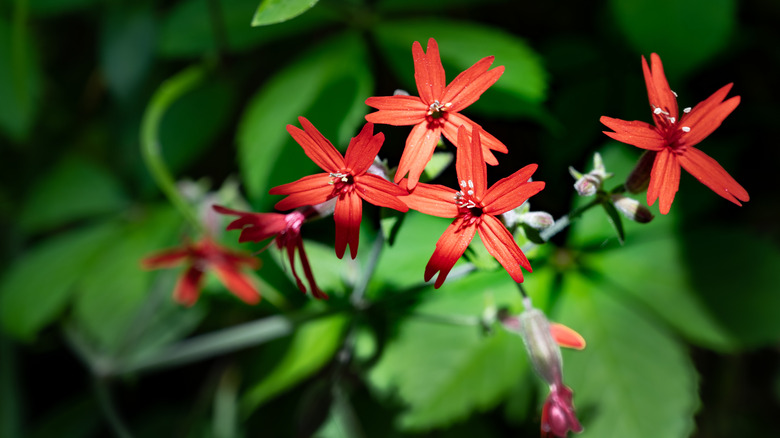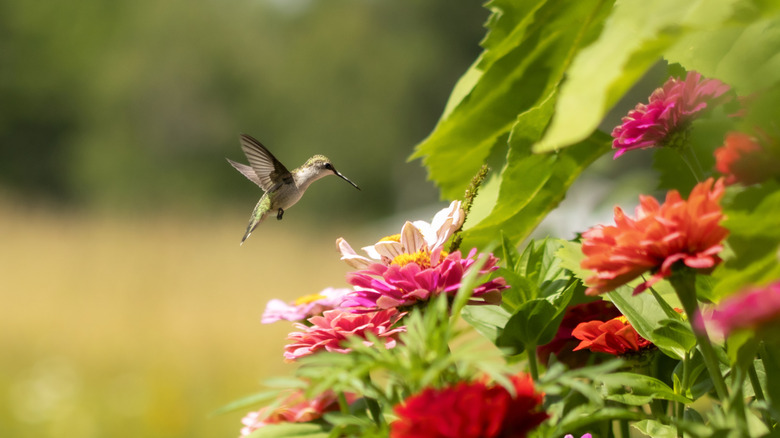Plant This Striking Flower To See More Hummingbirds In Your Yard
Hummingbirds — of the Trochilidae family — are avians unique to the Western hemisphere, and have a long history with native peoples of the Americas. For example, hummingbirds represented good luck in pre-Columbian Mexican cultures, and they were sometimes seen as messengers from the afterlife. In more practical terms, it's worth making your home into a hummingbird sanctuary because they pollinate your plants and eat small insects that might cause damage to the foliage. Hummingbirds need nectar and bugs to keep their tiny bodies going; the females can eat upwards of 2,000 bugs every day. One plant you can grow to get the best bang for your hummingbirds' buck is fire pinks (Silene virginica), also known as scarlet catchflies.
Fire pinks are herbaceous perennials that are native to the United States, thriving in USDA Hardiness Zones 4 through 8, covering all but the hottest regions on the western seaboard and the Gulf of Mexico. These beautiful red flowers begin to bloom in the spring and summertime, making them a perfect food source for hummingbirds migrating from lowlands to the mountains during that period. North Carolina State University horticulturalist Charlotte Glen told MarthaStewart.com that fire pinks are "irresistible to hummingbirds" after the winter season. Among the many flowers that will turn your home into a hummingbird paradise, scarlet catchflies are a low-maintenance option that will bring a lot of joy to you and your flying friends.
Treat your garden to hummingbird-attracting Silene virginica
Silene virginica being viable in most stretches of the U.S. means it's best to focus your garden and yard on particular growth conditions. These plants can thrive in anything from clay-based to shallow rocky soil, so long as it's consistently moist (with some dry periods) and has good drainage. One important detail is to make your soil more acidic; to decrease the pH level, try incorporating elemental sulfur, compounds like ammonium sulfate, or sphagnum peat moss. Growing fire pinks requires partial shade conditions, or at least dappled light. It can grow in full sun, too, but doesn't do well with deep shade.
There's no need to worry about living in dry regions if you want to grow your own crop of scarlet catchflies. On top of its ability to grow decently well in poor-quality soil, Silene virginica is also a fire-resistant plant. This makes it an ideal plant to help rebuild hummingbird populations in regions like California that face frequent wildfires, and they can be propagated by both seeds and cuttings. It's easier to attract hummingbirds to your garden with a layout that groups lots of food together, and the stand-out red flowers that come with Silene virginica could make for a great centerpiece.
Create a hummingbird haven with Silene virginica as the centerpiece
Hummingbirds are just one type of pollinator you're likely to attract if you try to grow fire pinks. These plants will also bring butterflies to your garden, and their seeds make great food for songbirds like sparrows and larks. There are a number of complementary plants that you can plan to seed alongside fire pinks to make a truly effective pollinator garden. More native plants that thrive in acidic soil conditions include blazing stars (Liatris spicata), mountain mint (of the Pycnanthemum genus), and various sunflowers like Helianthus angustifolius or Helianthus microcephalus. Plants like milkweed are also classic attractive options for pollinators like butterflies and bees.
Persicaria orientalis is a tall, self-seeding flower that will attract hummingbirds. It makes for a great companion to Silene virginica in terms of giving your garden a unique, attractive layering. Fire pinks can grow around 2 to 3 feet tall, but Persicaria orientalis towers closer to 7 feet. Hummingbirds have to eat every 10 to 15 minutes or so if they hope to maintain their active lifestyle, with hearts beating more than 1,200 times per minute. So, the more food you're able to plant, the better. With scarlet catchflies not only providing nectar but also being coated in a sticky substance that traps small insects, they're a perfect option if you long to see more hummingbirds in your yard.


